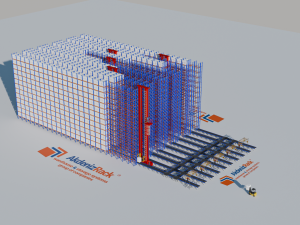AS/RS Automatic Storage and Retrieval Systems
An Automated Storage and Retrieval System (ASRS) consists of
Rack Systems, Stack Lifting Crane Systems, Automated Guided Vehicles (AGVs),
Autonomous Mobile Robots (AMRs), Conveyor Systems, and Management and Control
Systems. This system represents the most advanced automatic technology used in
the logistics industry. In the rack system, storage areas are available in all
standard sizes. AS/RS is widely used in various industries. It comprises
assembly racks and welding racks. Supported by transfer loaders, conveyor
systems, and computer control systems, it ensures the fullest utilization of
storage space, transportation mechanization, and modernization of storage
management.
ASRS with Pallet Racking Feature
The automated storage and retrieval system comprise rack
systems, crane systems, conveyor systems, and management and control systems.
This system represents the most advanced automatic technology used in the
logistics industry. In the rack system, storage areas are available in all
standard sizes. The automatic crane operates within the rack system and
facilitates load access. AS/RS is widely used in various industries. Pallet
racking ASRS utilizes selective pallet racking as the rack system. The main feature
is that each level consists of cargo of the same size. Clearance is arranged to
face the rack aisle for crane travel and cargo access.
Multi Layer 4 Way Shuttle System
A system called the "Multi Layer 4 Way Shuttle
System" is a type of automated storage and transportation system. This
system is used for storing, retrieving, and transporting materials in a
warehouse or manufacturing facility. It is commonly used to meet large-scale
storage needs and is frequently seen in modern storage and logistics systems
with high levels of automation.
This system typically consists of the following
components:
Storage Area: Usually created using rack systems or
specialized storage units. It represents the area where materials are stored.
4 Way Shuttle: This is an automated vehicle used to
move materials within the storage area. It can move in four directions
(forward, backward, right, and left) and transports materials within the rack
systems in the storage area.
Multi-Layer Structure: This system organizes the
storage area into multiple layers, providing more storage capacity in the same
area.
Control System: Typically an automation system
managed by a computer or central control unit. It controls the flow of
materials, manages inventory, and monitors system performance.
This system enables effective storage and management of
materials in the storage area. Thanks to its automation features, material
movement and inventory management are carried out automatically without the
need for human intervention. This reduces labor costs and increases warehouse
efficiency.
This system has many advantages, especially in terms
of automation and efficiency:
1. High Capacity: The Multi Layer 4 Way Shuttle
System increases storage capacity and allows for more efficient use of
available space due to its multi-layered structure. 2. Automation: With
its automatic operation feature, it minimizes human intervention and automates
storage processes, reducing labor costs and error rates. 3. Fast Access:
The system's multi-layered structure provides fast access to products,
shortening order preparation times and increasing customer satisfaction. 4. Flexibility:
The Multi Layer 4 Way Shuttle System can be used flexibly for different types
and sizes of products, allowing the storage space to be adapted to various
needs. 5. Less Storage Space Requirement: Thanks to its vertical
structure, less horizontal space is needed, resulting in cost savings in
property costs. 6. Efficiency and Cost Reduction: Factors such as
automation, fast access, and more efficient use of space increase overall
efficiency while reducing operating costs. 7. Sustainability: Factors
such as reduced space usage, energy savings, and lower labor requirements
provide advantages in terms of sustainability.
Stacker Crane + Pallet Shuttle System
The Radio Shuttle and stacking solution enable the dense
storage of palletized products. Leveraging mature stacking technology, the
system achieves dense storage functionality by increasing tunnel depth and
reducing the number of stackers. Additionally, it enables the fully automatic
operation of shuttles, stackers, conveyor machines, and other equipment through
the use of WMS/WCS control systems. This system significantly increases
material density in the warehouse, performs random storage according to FIFO
logic, eliminates forklift passage, and supports storage space. As a result, it
reduces forklift entry and exit times, decreases workers' operating time, and
meets customers' dense storage requirements. Crane-supported pallet handling
systems are used in warehouses or industrial facilities for the automatic
storage, transportation, and placement of materials. They are preferred in
large storage facilities and facilitate the rapid processing of large quantities
of materials. These systems have an integrated structure of cranes and pallets.
Cranes lift and lower materials by moving along rails, while pallets facilitate
the movement of materials and are typically durable metal or plastic platforms.
The system optimizes warehouse management by working in coordination with
automation and control systems. These systems are commonly used in large
distribution centers, manufacturing facilities, and logistics centers,
utilizing warehouse space more efficiently and reducing labor. High Storage
Capacity: It provides maximum storage capacity by utilizing vertical
storage space. Automation and Efficiency: By its automatic operation
feature, it automates material handling and storage processes, thus speeding up
operations and reducing human errors. Quick Access and Organized Storage:
It enables quick access to materials and organizes storage space in an orderly
manner, facilitating easy retrieval of materials. Labor Savings: Automatic
storage systems require less human labor compared to manual operations, which
can reduce operating costs. Flexibility: It can have flexible
configurations to adapt to different storage needs and pallet types.
Stacker Crane With Conveyor System
The system comprises high-level stereo racks, automatic
stacking, a conveyor line, Warehouse Control System (WCS), Warehouse Management
System (WMS), and associated peripherals. Depending on actual application needs
and investment budget, the Palletizer can be single/double-row, flat/fork type,
or other different variations. The retrieval unit can select trays or material
boxes, while the conveyor line may prefer a drum-type conveyor.
Stacker Crane with Conveyor System is an automation
system used in warehouses or manufacturing facilities. This system facilitates
the storage, transportation, and processing of materials, making it ideal for
managing intensive material movement in large warehouses and manufacturing facilities.
This system consists of two main components:
Stacker Crane: A machine that can move on warehouse
rack systems and access high shelves. It operates automatically and is
controlled by computer or programmable logic controllers.
Conveyor System: Enables the transportation of
materials from one point to another. Various conveyor types are used depending
on the type and size of the material.
Stacker Crane with Conveyor System automates the
retrieval, storage, processing, and shipment of materials. This increases
efficiency, reduces errors, and ensures effective use of warehouse/production
space.
Advantages: High Storage Capacity: Stacker Crane is
an automatic system capable of vertical storage. This increases storage
capacity and allows more products to be stored within the same area. Automatic
and Fast Operation: Stacker Crane operates automatically and when
integrated with a conveyor system, it can quickly pick up, store, or transport
products. This increases warehouse efficiency and reduces the risk of human
error. Space Efficiency: Vertical storage allows for more efficient use
of warehouse space. This advantage enables maximizing valuable space to fit
more products within the same area. Workplace Safety: Stacker Crane and
Conveyor System minimize human intervention, enhancing warehouse worker safety
as direct contact with hazardous equipment is not necessary. Time and Cost
Savings: Automatic operation and fast processing lead to time and cost
savings in businesses. Faster product handling, storage, and shipping processes
generally improve overall operational efficiency. Lower Operating Costs:
Implementing automatic systems can reduce operating costs in the long term.
Decreased labor requirements can lower labor costs, and automatic systems
requiring less maintenance can reduce maintenance costs. Data Monitoring and
Management Ease: Stacker Crane and Conveyor System are often integrated
with automation and data monitoring systems. This makes inventory management,
stock tracking, and transaction data monitoring easier, aiding business
managers in making better decisions.







-300x225h.png)
-300x225w.png)
-300x225.png)
-300x225h.png)
-300x225w.png)
-300x225w.png)
-300x225h.png)
-300x225w.png)
-300x225h.png)
